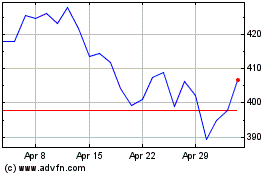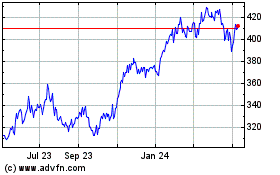Cloud Business Boosts Microsoft's Earnings -- 2nd Update
April 26 2018 - 6:29PM
Dow Jones News
By Jay Greene
Microsoft Corp. extended its streak of wins in the latest
quarter as the software giant moves into an era where its venerable
Windows franchise plays a supporting role to its burgeoning
cloud-computing operations.
The cloud business, called Azure, jumped 93% in the fiscal third
quarter, Microsoft reported Thursday. The business has never grown
slower than 90% since the company began reporting the metric in
October 2015. The other big piece of the company's cloud
operations, the commercial version of its Office 365
online-productivity service, grew 42%.
Microsoft doesn't disclose revenue for either business, but in
the preceding second quarter it said Azure jumped 98% and
commercial Office 365 grew 41%.
The two businesses combined accounted for $6 billion in revenue,
up 58% on what Microsoft financial chief Amy Hood said was
"better-than-expected demand."
Ms. Hood pointed to 20% growth in Microsoft's server-products
and cloud-services revenue as a reflection of its focus on the
so-called hybrid cloud, in which customers mix cloud services with
software running on servers in their own data centers.
Microsoft has capitalized on its legacy as a seller of server
software to win over its longtime customers who choose to gradually
move their operations to the cloud.
That growth has propelled Microsoft into the role of chief cloud
rival to Amazon.com Inc., which pioneered the business of renting
out computing power and storage a decade ago.
"Two years ago, there was a clear No. 1 with no clear No. 2,"
said Stifel Nicolaus & Co. analyst Brad Reback. "There is no
doubt that Microsoft has put significant distance between
themselves and all of the other" Amazon rivals.
The surging cloud business led Microsoft to post a profit
increase of 35% to $7.42 billion, or 95 cents a share. Revenue rose
16% to $26.82 billion. Analysts surveyed by S&P Global Market
Intelligence expected Microsoft to report per-share earnings of 85
cents on revenue of $25.78 billion.
Microsoft no longer reports adjusted figures, reflecting
accounting changes it adopted at the start of the fiscal year. The
year-ago figure reflects that change.
Microsoft's stock was down 0.3% in after-hours trading, after
finishing the day at $94.27, up 2.1%. Last month, Microsoft shares
hit an all-time high of $96.77, a gain of nearly 40% over the past
year. The company has jostled with Alphabet Inc. and Amazon for the
No. 2 spot behind Apple Inc. as the world's most valuable company
as measured by market capitalization.
Microsoft's Azure business is part of its Intelligent Cloud
segment. Revenue from that unit rose 17% to $7.9 billion. The
Office franchise is part of Microsoft's Productivity and Business
Processes segment, where revenue climbed 17% to $9.01 billion.
The company continues to dole out huge sums building massive
data centers around the globe to battle Amazon and others. In the
quarter, Microsoft had $3.5 billion in capital expenses, with much
of that money going toward its data-center expansion. A year ago,
Microsoft had $2.1 billion in capital expenditures
Microsoft doesn't break out revenue for its Windows business.
Earlier this month, International Data Corp. reported world-wide PC
shipments showed no growth in the most recent quarter.
Revenue in Microsoft's More Personal Computing segment, which
includes the company's slow-growing Windows franchise as well as
the mobile-phone and Xbox gaming businesses, gained 13% to $9.92
billion.
A month ago, Microsoft split the engineering group that develops
products under the Windows banner among two separate divisions. It
was a recognition that the product that had been synonymous with
Microsoft for most of its 43 years will now play a supporting role
to the company's cloud-computing efforts.
Even as Microsoft has shifted its focus away from Windows, the
operating system showed surprising resiliency. Revenue in the
version of Windows that Microsoft generally sells to corporate
customers, known as OEM Pro, grew 11%. And revenue from Microsoft's
Surface line of computers jumped 32% to $1.10 billion.
LinkedIn, the professional social network Microsoft bought for
$27 billion more than a year ago, grew rapidly, with revenue
climbing 37% to $1.34 billion.
Write to Jay Greene at Jay.Greene@wsj.com
(END) Dow Jones Newswires
April 26, 2018 18:14 ET (22:14 GMT)
Copyright (c) 2018 Dow Jones & Company, Inc.
Microsoft (NASDAQ:MSFT)
Historical Stock Chart
From Mar 2024 to Apr 2024

Microsoft (NASDAQ:MSFT)
Historical Stock Chart
From Apr 2023 to Apr 2024
